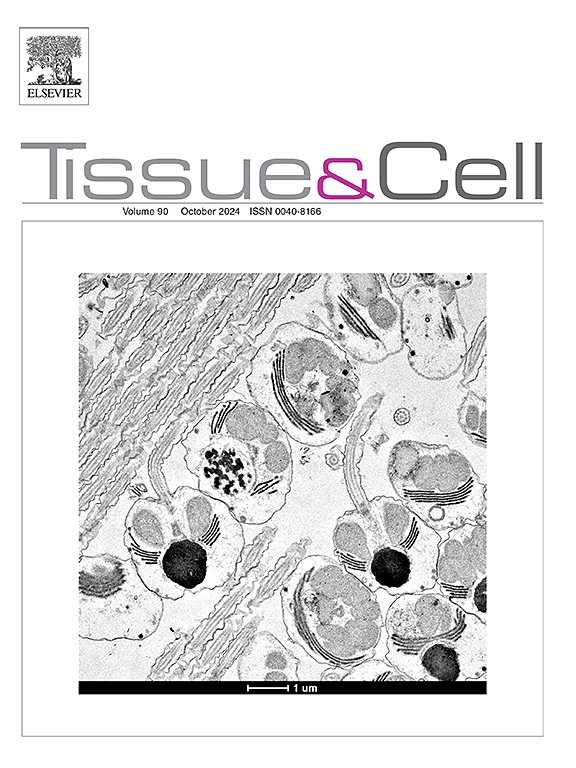Mechanism of EZH2-mediated histone methylation promoting bFGF-induced angiogenesis of human umbilical vein endothelial cells
IF 2.7
4区 生物学
Q1 ANATOMY & MORPHOLOGY
引用次数: 0
Abstract
This study aims to explore the role of enhancer of zeste homolog 2 (EZH2)-mediated histone methylation in basic fibroblast growth factor (bFGF)-induced angiogenesis of human umbilical vein endothelial cells (HUVECs). EZH2, vascular endothelial growth factor A (VEGFA), miR-340–5p, and nuclear factor-erythroid 2-related factor 2 (NRF2) expressions in bFGF-induced HUVECs were detected by real-time quantitative polymerase chain reaction (RT-qPCR) and Western blot. After transfection of EZH2 siRNA, NRF2 siRNA, or miR-340–5p inhibitor, cell migration and angiopoiesis were assessed by Transwell and tube formation assays. Chromatin immunoprecipitation (ChIP) was performed to analyze the enrichment of EZH2 or trimethylated H3 lysine 27 (H3K27me3) on NRF2 promoter. The binding between NRF2 and miR-340–5p was verified by ChIP and dual-luciferase assay. EZH2 was highly expressed while miR-340–5p and NRF2 were poorly expressed in bFGF-induced HUVECs. Silence of EZH2 restrained HUVEC migration, and reduced the number of branches and tube length. Mechanically, EZH2 enhances the enrichment of H3K27me3 on the NRF2 promoter, thereby repressing NRF2 expression and further leading to transcriptional repression of miR-340–5p. In conclusion, EZH2 inhibits the NRF2/miR-340–5p axis and promotes bFGF-induced angiogenesis of HUVECs by increasing the H3K27me3 modification on the NRF2 promoter.
ezh2介导的组蛋白甲基化促进bfgf诱导的人脐静脉内皮细胞血管生成的机制
本研究旨在探讨zeste homolog 2 (EZH2)增强子介导的组蛋白甲基化在碱性成纤维细胞生长因子(bFGF)诱导的人脐静脉内皮细胞(HUVECs)血管生成中的作用。采用实时定量聚合酶链反应(RT-qPCR)和Western blot检测bfgf诱导的huvec中EZH2、血管内皮生长因子A (VEGFA)、miR-340-5p和核因子-红细胞2相关因子2 (NRF2)的表达。转染EZH2 siRNA、NRF2 siRNA或miR-340-5p抑制剂后,通过Transwell和管形成试验评估细胞迁移和血管生成。采用染色质免疫沉淀法(ChIP)分析NRF2启动子上EZH2或三甲基化H3赖氨酸27 (H3K27me3)的富集情况。通过ChIP和双荧光素酶实验验证NRF2与miR-340-5p的结合。在bfgf诱导的huvec中,EZH2高表达,miR-340-5p和NRF2低表达。EZH2的沉默抑制了HUVEC的迁移,减少了分支数和管长。机械上,EZH2增强了NRF2启动子上H3K27me3的富集,从而抑制NRF2的表达,进而导致miR-340-5p的转录抑制。综上所述,EZH2抑制NRF2/ miR-340-5p轴,通过增加NRF2启动子上的H3K27me3修饰,促进bfgf诱导的HUVECs血管生成。
本文章由计算机程序翻译,如有差异,请以英文原文为准。
求助全文
约1分钟内获得全文
求助全文
来源期刊

Tissue & cell
医学-解剖学与形态学
CiteScore
3.90
自引率
0.00%
发文量
234
期刊介绍:
Tissue and Cell is devoted to original research on the organization of cells, subcellular and extracellular components at all levels, including the grouping and interrelations of cells in tissues and organs. The journal encourages submission of ultrastructural studies that provide novel insights into structure, function and physiology of cells and tissues, in health and disease. Bioengineering and stem cells studies focused on the description of morphological and/or histological data are also welcomed.
Studies investigating the effect of compounds and/or substances on structure of cells and tissues are generally outside the scope of this journal. For consideration, studies should contain a clear rationale on the use of (a) given substance(s), have a compelling morphological and structural focus and present novel incremental findings from previous literature.
 求助内容:
求助内容: 应助结果提醒方式:
应助结果提醒方式:


